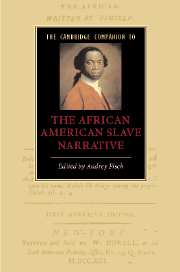Book contents
- Frontmatter
- Introduction
- Part I: The Slave Narrative and Transnational Abolitionism
- Part II: The Slave Narrative and Anglo-American Literary Traditions
- Part III: The Slave Narrative and the African American Literary Tradition
- Part IV: The Slave Narrative and the Politics of Knowledge
- 11 Harriet Jacobs: a case history of authentication
- 12 Frederick Douglass’s self-fashioning and the making of a Representative American man
- 13 Beyond Douglass and Jacobs
- 14 Black womanhood in North American women’s slave narratives
- Further Reading
- Index
13 - Beyond Douglass and Jacobs
from Part IV: - The Slave Narrative and the Politics of Knowledge
Published online by Cambridge University Press: 28 July 2007
- Frontmatter
- Introduction
- Part I: The Slave Narrative and Transnational Abolitionism
- Part II: The Slave Narrative and Anglo-American Literary Traditions
- Part III: The Slave Narrative and the African American Literary Tradition
- Part IV: The Slave Narrative and the Politics of Knowledge
- 11 Harriet Jacobs: a case history of authentication
- 12 Frederick Douglass’s self-fashioning and the making of a Representative American man
- 13 Beyond Douglass and Jacobs
- 14 Black womanhood in North American women’s slave narratives
- Further Reading
- Index
Summary
Not very long ago, students taking a standard Survey of American Literature course that covered the years up to the Civil War would have encountered just one slave narrative, The Narrative of the Life of Frederick Douglass, an American Slave, first published in 1845. These days, students in that course are likely to encounter two slave narratives - or rather, one complete narrative and about one-seventh of another. Both The Norton Anthology of American Literature, 1820-1865 and The Heath Anthology of American Literature - Early Nineteenth Century: 1800-1865 include exactly six of the forty-one chapters of Harriet Jacobs's Incidents in the Life of a Slave Girl. The Heath Anthology also includes the work of four other African American writers, all collected together with Douglass and Jacobs in the section entitled “Race, Slavery and the Invention of the 'South.'” In this volume of the Norton Anthology, Douglass and Jacobs are the only African American writers represented. Students who continue in the survey might encounter one or two other narratives - perhaps Booker T. Washington's Up From Slavery (1901), for example. Most students interested in American literary history, then, and many of their teachers, will encounter fewer than a handful of narratives that will represent a genre that includes an estimated 6,000 texts - including books, periodical publications, and oral histories and interviews. Even in courses not burdened by the constraints of historical coverage that makes any survey course a challenge, Douglass’s 1845 Narrative and Jacobs’s Incidents (read in its entirety) are often the only slave narratives assigned; similarly, a great deal of scholarship on American literary and cultural history includes significant discussions only of Douglass (most often) or of Jacobs, or of the two together.
- Type
- Chapter
- Information
- The Cambridge Companion to the African American Slave Narrative , pp. 218 - 231Publisher: Cambridge University PressPrint publication year: 2007
- 6
- Cited by

